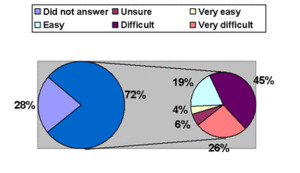Self-exclusion, a program “that enables individuals to have themselves banned from entering a casino” (Nowatzki, 2002, p. 3), has been a much discussed and controversial topic since its recent inception. We do not yet have studies that assess the impact of selfexclusion programs. However, the Victorian Gambling Research Panel commissioned the South Australian Centre for Economic Studies to study self-exclusion in Australia during 2001-2002 (South Australian Centre for Economic Studies, 2003). This week’s WAGER reviews data from this study on the self-perceived ability of gambling venues to enforce self-exclusion bans, an important element of successful self-exclusion.
The research group mailed 150 surveys consisting of 20 open and closed response questions to casinos and gambling centers throughout Victoria, Australia. Ninetythree gambling venues responded (55 clubs and 38 hotels) for a response rate of 63%. Most of the venues (72%) rated their experience in identifying selfexcluded problem gamblers who violated their selfexclusion contract on a 5 point scale from “very easy” to “very difficult.” Figure 1 shows that 71% of the respondents reported that “in their experience” it was either “difficult” or “very difficult” to identify a selfexcluded gambler; relatively few (23%) reported it was “easy” or “very easy.” The researchers suggested that perhaps casinos underestimate the likelihood of the program’s effectiveness because of a “conflict of interest where enforcing self-exclusion may impact directly on operator income” (South Australian Centre for Economic Studies, 2003, p. 12).
Figure 1. Managers’ estimates of ease of identification by staff: Percent non-respondents, percent respondents and distribution of ratings.
This study suggests that gaming venues do not expect self-exclusion programs to be easily enforced.
The study was not without limitations. The survey was addressed to “the manager,” but the report does not indicate who completed the survey. We might expect answers to vary depending on the respondent’s role and responsibilities. The study obtained responses from relatively few venues and consequently may not generalize to all gaming venues in Victoria, venues in Australia, or to venues in other countries. The authors provide many suggestions for improving self-exclusion programs. Some of these include: improving methods of photographic imaging and printing, increasing program funding, developing a statewide central administration, and creating more concrete sanctions for program violations. In addition, gambling venues might be given statewide incentives to enforce and uphold this system, such as positive publicity in the form of community service awards, or taxable sanctions for lack of compliance. More research is needed to determine whether any of these strategies will be successful in promoting and enforcing self-exclusion.
Comments on this article can be addressed to Mike Stanton.
References
Australian Gaming Council. (2002). Current Issues Related to Identifying the Problem Gambler in the Gambling Venue. South Australian Centre for Economic Studies.
Nowatzki N. et al., (2002). Casino Self-exclusion Programmes: A Review of Issues. International Gambling Studies, Vol. 2, pp. 3-25.
South Australian Centre for Economic Studies. (2003). Evaluation of Self-Exclusion Programs (Part A : Evaluation of Self-Exclusion Programs in Victoria) (2). Victoria, Australia: The Victorian Gambling Research Panel.





